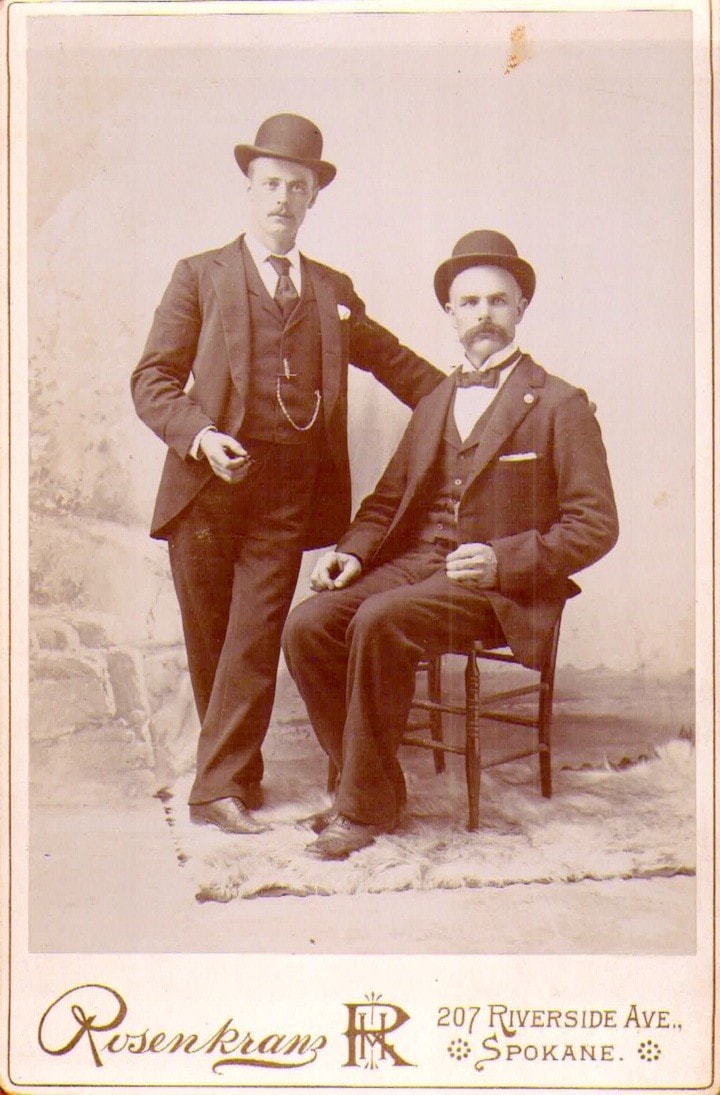Third in a series
So far in this series we’ve established the Langham building in Kaslo was erected in 1896-97 by Charles J. Kapps and operated as a rooming house by Ella Case and Sarah Warner.
Kapps’ Slocan Bottling Works apparently operated out a southeast extension to the building which no longer exists. Kapps had a couple of partners — William Chappell and then Thomas Mitchell — but neither lasted long. The business, however, thrived once Kapps added liquor wholesaling.
The Nelson Tribune of March 21, 1899 reported him “very much pleased” at receiving a rail shipment of ale and beer from Toronto “in the remarkably fast time of 13 days.” A 1901 billhead also reveals he was the local distributor for the Pabst Brewing Co.
But Kapps apparently did even better speculating in mining properties. According to The Ledge of October 1, 1908: “Years ago Charley Kapps came to Kaslo and drove a dray. Billy Adams was superintendent of the Rambler and a friend of Kapps. He advised him to buy Rambler stock. Charley did so and laid the foundation of a fortune.” (The Rambler-Cariboo mine was one of the more consistent silver producers in the Slocan.)
 Kapps returned to his native Germany in 1900 to visit his mother. The 1901 census found him back in Kaslo living with John A. Calendar, who was employed in the bottling works, and miner Donand McDonald.
Kapps returned to his native Germany in 1900 to visit his mother. The 1901 census found him back in Kaslo living with John A. Calendar, who was employed in the bottling works, and miner Donand McDonald.
In 1902, Kapps resigned from the Rambler-Cariboo board, sold his shares for a reported $80,000 (in the neighbourhood of $2.1 million today), sold his bottling works, and moved to Edmonton, where he started a meat packing plant.
On March 30, 1903, Kapps married Amalie Lechelt in Spokane. He and his new bride visited Kaslo a few days later where he was “congratulated by his many friends.”
The couple apparently moved to Vancouver. In 1905, Kapps was reported to be looking at starting a brewery in Hedley. By the fall of 1906, he built the Kaiser Hotel at 230 Main Avenue in Spokane, and added on to it early the following year. In 1908, with partner William Hastie he paid $175,000 for the Frankfort building at the southwest corner of Main and Howard in Spokane and was planning a $125,000 addition.
Unhappy wives
Things were not going as well on the homefront, however. Kapps and his wife divorced, and by late 1907 she remarried. He also found a new partner, Mary Louise Toussaint, a divorcee whom he wed in Butte, Montana, on April 12, 1910.
She was apparently then four months pregnant with their son, William Adam, born in Spokane on September 1. A daughter, Meta Elizabeth, followed on August 1, 1912 (the two are seen at left). Louise also had two  daughters from her earlier marriage.
daughters from her earlier marriage.
Kapps shows up in the Spokane civic directory in 1909 as manager of the former Kaiser Hotel — now called the US Hotel. Around 1914 he started the Bremen Investment Co., named for the German city in which he was born, and carried on business until at least 1940. Among other things, he was a director of the Deep Wonder Mining Co., which had silver-lead properties in Idaho.
In 1916, Louise asked for a divorce and custody of their children, complaining that Kapps refused to live with or support her for a year.
Although the couple appears to have reconciled, court proceedings revealed the extent of Kapps’ Spokane real estate holdings, which included his half interest in the Bremen Investment company property, valued at $200,000, plus lots in Merritt Park, Chandler’s Addition, and a farm near Colbert.
Louise died on September 16, 1919, age 36, though the cause isn’t clear. Kapps moved to S319 Monroe, but remained in Spokane until about 1949. He died in Seattle on July 20, 1958, age 92.
He was survived by his daughter Meta and step-daughter Isabell. His son William died in Phoenix in 1929 of meningitis at age 18 following a bout with the flu, although family legend has it that he was in a motorcycle accident. Another step-daughter, Mary Ellen, died as a young child, possibly of diphtheria.
 Isabell’s great granddaughter, Jennifer Small, lives near Seattle and has visited Kaslo in pursuit of Kapps’ story. She provided the never-before published photos seen here.
Isabell’s great granddaughter, Jennifer Small, lives near Seattle and has visited Kaslo in pursuit of Kapps’ story. She provided the never-before published photos seen here.
She was surprised to learn of the marital discord between Kapps and his second wife: “From what I knew about him he seemed like such a wonderful man. It was odd to hear that [Louise] accused him of no support.”
She also says Kapps was very kind to Isabell, who took care of him in his old age.
Kapps’ aqua-coloured bottles from his Slocan Bottling Works (seen at left) are highly prized by collectors, particularly an example with three spelling mistakes that reads “CHOPPELL & KOPPS / CASLO BC” instead of CHAPPELL & KAPPS / KASLO BC.”
One such bottle sold online for $866 US a few years ago. Oddly, no one has ever seen a corrected version.
Next: The Langham Boys
Previously
